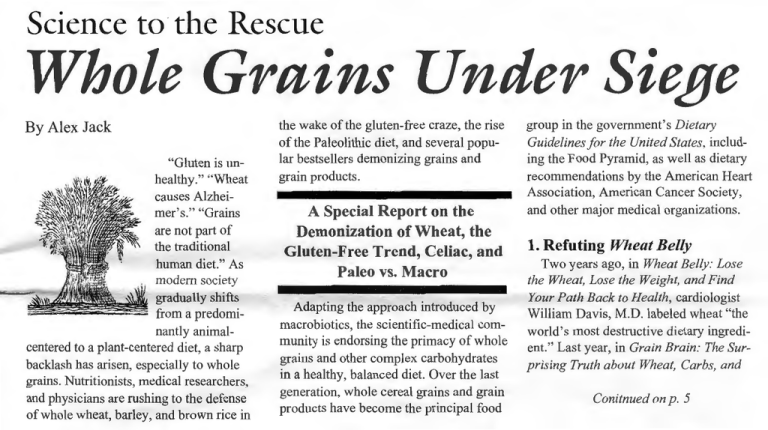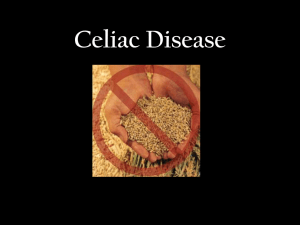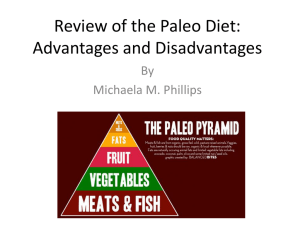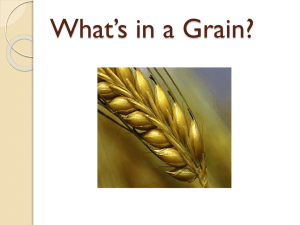Whole Grains Under Siege
advertisement

Science to the Rescue Whole Grains Under Siege By Alex Jack "Gluten is unhealthy." "Wheat causes Alzheimer's.'' "Grains are not part of the traditional human diet." As modern society gradually shifts from a predominantly animalcentered to a plant-centered diet, a sharp backlash has arisen, especially to whole grains. Nutritionists, medical researchers, and physicians are rushing to the defense of whole wheat, barley, and brown rice in the wake of the gluten-free craze, the rise of the Paleolithic diet, and several popular bestsellers demonizing grains and grain products. A Special Report on the Demonization of Wheat, the Gluten-Free Trend, Celiac, and Paleo vs. Macro Adapting the approach introduced by macrobiotics, the scientific-medical community is endorsing the primacy of whole grains and other complex carbohydrates in a healthy, balanced diet. Over the last generation, whole cereal grains and grain products have become the principal food group in the govemment's Dietary Guidelines for the United States, including the Food Pyramid, as well as dietary recommendations by the American Heart Association, American Cancer Society, and other major medical organizations. 1. Refuting Wheat Belly Two years ago, in Wheat Belly: Lose the Wheat, Lose the Weight, and Find Your Path Back to Health, cardiologist William Davis, M .D. labeled wheat "the world's most destructive dietary ingredient." Last year, in Grain Brain: The Surprising Truth about Wheat, Carbs, and Conitnued on p. 5 Science to the Rescue Continued from p. 1 Sugar- Your Brain's Silent Killers, neurologist David Perlmutter, M.D. contended that "during 99.9% of our time walking this earth we have never eaten grain." Like many adherents of the modem Paleolithic Diet, he recommends a daily regimen consisting of about 75% fat, 20% protein, and 5% carbs. Challenging these claims, the Tufts Health & Nutrition Letter this spring featured a lead article on "The Truth About the War on Wheat." "There is a lack of scientific evidence to support the claims that eating wheat is an independent riskfactor for greater abdominal adiposity or weight gain," stated Nicola McKeown, Ph.D., an associate professor at Tufts' Friedman School. "In my opinion, educating consumers about how to identify healthier whole-grain options to replace refined grains and how to incorporate ancient grains into our diets is important." In a "Gut Check" of the "dubious" and "sensational" assertions in Wheat Belly, the article went on to cite a 2010 study that found that increasing consumption of at least three daily servings of whole wheat, brown rice, oatmeal, and other whole-grains was linked with10% lower VAT (visceral adipose tissue or belly fat) in test subjects. The findings followed another study that found "higher intakes of cereal fiber, particularly from wholegrain sources, are associated with lower total percent body fat and percent trunk fat mass in older adults." Cynthia Harriman, director of food and nutrition strategies at the Whole Grains Council, dismissed Grain Brain's characterization of grains as "a terrorist group that bullies our most precious organ, the brain" as misleading, sensational, and full of distortions. She cited a study in the American Journal of Clinical Nutrition of 3831 men and women, aged 65 and up, whose cognitive function improved with greater intake of whole grains, legumes, and nuts. In contrast, a recent study found that women on an Atkins' style lowcarbohydrate diet experienced gradual memory loss. PAGE 6 "If you don ' t eat grains, it's difficult to consume enough dietary fiber," the Tufts article concluded. "The typical gluten-free diet contains only about 6 grams of dietary fiber per day, far short of the Institute of Medicine's target of25-38 grams daily ... wheat isn:t the bogey "Increasing consumption of at least three daily servings of whole wheat, brown rice, oatmeal, and other whole-grains was linked withl0°/o lower VAT (visceral adipose tissue or belly fat) in test subjects." man that these books claim ... choose a variety of whole grains, including brown rice, oats, quinoa, faro , popcorn, and so on ... Consumed in delicious moderation, [whole grain fare] is designed to be good for both your belly and your brain." The Harvard School of Public Health also emphasizes whole grains as part of a foundation for a healthy diet. Its "Healthy Eating Plate" calls for 25% of daily food consumption to consist of cereal foods: "Whole and intact grainswhole wheat, barley, wheat berries, quinoa, oats, brown rice, and foods made with them, such as whole wheat pastahave a milder effect on blood sugar and insulin than white bread, white rice, and other refined grains." 2. The Gluten Craze "Thou shalt not eat wheat." The first commandment in today's glutenfree modem society is rapidly replacing giving thanks for "Our daily bread." Millions of people are now ritually shunning wheat, barley, rye, oats, and other · gluten-rich grains that were traditionally revered as the Staff of Life. Gluten, the protein component in wheat and other starchy cereals, gives dough its elasticity, helping it to rise, keep its shape, and add to its chewiness. In the United States, an estimated 3 million people have celiac disease, an autoimmune disorder that affects the small intestine, and another 18 million people have gluten sensitivities that can manifest as bloating, pain, gas, constipation, diarrhea, joint pain, and headaches . Beer, bread, cakes, pies, pastries, soy sauce, and many other processed foods can provoke these symptoms. As with many nutritional crazes, the rise of gluten intolerance has spawned an avalanche of new wheatless products. In America, thousands of foods in supermarkets, natural food stores, and schools are labeled as "gluten free," even if they contain no cereal components or protein. Menus in restaurants often have a GF sign next to dishes that are without gluten. From overweight and obesity to irritability and depression, wheat and other glutinous foods are routinely identified as the chief nutritional suspects. Going gluten-free has fueled not only the fastest growing segment of the food industry, but also proved a boon to a new medical fraternity . Specialists known as Gluten Doctors thrive in treating people suffering from real or imaginary illness. In many countries, celiac disease is rare. For example, in Japan, gluten sensitivity is about one-fifth as common as in America or Europe. From an evolutionary view, the gluten-free trend is worrisome because for millions of years, our ancestors have been eating wild or domesticated grains, and many of them are high in gluten. Why has gluten intolerance suddenly emerged as a major epidemic in the late 20th and early 21st centuries? There appear to be three reasons behind this trend. First, the modem food pattern is centered on animal food unlike the traditional food pattern that is plantbased. From an energetic view, meat, chicken, cheese, salmon, and other popular animal foods are classified as extremely yang. They give strong, contractive energy and as a rough balance attract light, refined grains, raw foods, excessive fruit, sugar, alcohol, and other more expansive, yin foods. Though not as extreme as animal food, whole grains also give strong, but centered yang energy. Since yang repels yang, meat and heavy animal food eaters are not attracted to whole grains. They prefer soft, white bread and other light, refined baked products, including doughnuts, croissants, and other pastries. Over time, consuming a combination of extreme yang and yin foods takes a toll on the intestines, and many people today can no longer absorb whole grains, including whole wheat, barley, and oats. Secondly, modem wheat is very different from traditional wheat. Beginning in the early 1960s, a new hybrid variety of wheat was introduced that produced higher yields but also required more chemical fertilizers and water. Soon the Green Revolution that it launched spread to India, Africa, and around the world, displacing heirloom varieties of seeds that had been used for millennia. Third, the method of milling wheat and other glutinous grains has fundamentally changed. Modem milling replaced traditional slow-grinding stones with high-speed steel hammers and rollers that process wheat into flour. Iron, zinc, selenium, and other nutrients are lost in the process, the industrial smashing creates chaotic effects, and the flour loses its Ki energy. The end result is the lifeless, puffy buns, breads, and rolls favored by fast food franchises, school cafeterias, and those who have little or no time to cook or bake in their own kitchens. "There is good evidence that ancient grains didn't have anything like the toxicity that current wheat does," says Peter Green, a gastroenterologist at Columbia University and author of Celiac Disease: A Hidden Epidemic. Medical studies are beginning to show that the gluten allergies and sensitivities that people experience are not to wheat and wheat products per se, but to the new industrial varieties of wheat and especially to yeasted bread and baked goods. For example, a 2007 study in Applied and Environmental Medicine found that when bread was naturally ferment- Goldilocks must have a gluten allergy. ed, it reduced gluten levels from about 75,000 parts per million to 12, a level that falls within the gluten-free range. Many people with gluten intolerances have found that by switching to natural "There is good evidence that ancient grains didn't have anything like the toxicity that current wheat does." sourdough wheat or rye bread their symptoms disappeared. For consumers, it is not enough to se- . lect "wheat," "whole wheat," or "organic" when shopping or eating out. Large commercial mills are still geared to producing primarily white flour by separating out the bran and germ. When a bakery orders whole-wheat flour, they simply recombine the bran and germ with the white flour. The process is similar to polishing brown rice into white rice and then enriching the white rice with the vitamins and minerals that have been removed. Most modem dietitians defend the practice, contending that the nutritional composition is the same. Holistic health care providers object torecombining. "It's like disassembling a car, then putting all the parts in a bowl and saying it's a car, observes Mark Shigenaga, Ph.D. an expert in digestion. A return to heirloom grains will go a long way to ending the gluten plague. Thorn Leonard, a macrobiotic baker in Georgia and author of The Bread Book, has been experimenting with growing traditional strains of wheat from Turkey and giving them to local farmers. He reports that most people he has met with wheat problems thrive with this variety. As the experience of sustainable wheat farmers and bakers like Thorn shows, people today are not really intolerant of wheat, barley, and other grains that nourished generations of their ancestors. They are allergic to the unhealthy and destructive practices of modem agriculture and food processing. 3. Why Celiac? Unlike most gluten intolerances, celiac disease (CD) is considered incurable. Eliminating gluten helps some sufferers maintain normal digestion. But virtually none goes on to heal to the point they can return to digesting wheat, barley, or other glutinous foods or products. Medical researchers classify CD as a genetic disorder of the small intestine. Exposure to gluten causes an inflammatory response that atrophies the villi and interferes with absorption. Over 95% of celiac patients have a specific gene variation that initiates an autoimmune response when gluten is ingested. The name celiac derives from the Greek word for "abdominal" and is traced back to a digestive disorder described by Aretaeus of Cappadocia in the first century. It is not known whether this was the same as modem CD, which was first described in the 1880s. In the 1940s, the condition was first linked to wheat. The fact that CD did not appear until recently suggests that it was not a disease of antiquity when wheat, barley, and other glutinous foods were consumed even more widely than today. Rather celiac appears to have arisen as a result of a major change in modem food technology. In the late 19th century, advancements in the refining of grains made cheap white bread widely available. One hypothesis is that consumption of too much refined flour and other adulterated gluten products led to a gene mutation that was inheritable among sus- ceptible family members. The process may be similar to the emergence of the BCRA gene mutation that affects about 1% of modem women. As described in Amberwaves' booklet Nutrition vs. Surgery: The Breast Cancer Controversy, BCRA is concentrated in women of Scandinavian, Icelandic, and Ashkenazi Jewish origin, all of whose ancestors consumed milk, cheese, or other dairy products in large quantities. Too much dairy evidently led to a mutation in the BCRA gene- a naturally occurring DNA repair gene- as girls and women lost their natural resistance to tumor development. In the case of celiac, the villi of the small intestine appear to have lost the ability to function properly after excessive exposure to refined flour, especially that made with commercial baker's yeast and other additives. There is also a connection with candidiasis. Candida, a naturally occurring yeast in the digestive tract, is usually harmless. But when it grows out of control, it produces symptoms similar to celiac. Candida and gluten share a similar protein sequence that can trigger an autoimmune reaction. Nausea, stomach pain, and chronic diarrhea typically accompany both conditions. Yeasted white bread, along with sugar and other depleting foods that are staples in the modem diet, appear to be the underlying dietary cause in both cases. As the new science of epigenetics is demonstrating, genes are not fixed and static, but can be modified in a positive as well as negative direction. Healthy diet, lifestyle, and moods can transform our health and vitality and shape and influence our chromosomes and be passed on to future generations. In a world with a sane agriculture and food system, celiac, the BCRA mutation, and other genetic disorders could diminish and become a relic of the past. 4. Paleo vs. Macro Paleo is one of the latest trends and refers to a diet that harkens back to the Stone Age. According to its proponents, Paleolithic humans hunted most of their daily food, and mastodon, antelope, bison, and other large mammals constituted PAGE 8 a majority of their fare. Only with the rise of agriculture and civilization, modem day Paleos contend, did humans produce and consume significant amounts of carbohydrates in the form of grain and grain products, including bread, baked goods, apd beer. Present day versions of the Paleo diet include mostly grass-fed beef and other livestock, fish, eggs, cultured dairy, vegetables, fruit, roots, tubers, seeds and nuts. For the most part, it eliminates grains, potatoes, sugar, processed oils, and other domestically grown or processed fare . Some Paleos eat small amounts of grain or grain products but soak them for up to 24 hours, sprout, or treat them with vinegar to re- "A new look at the diets of ancient African hominids shows a 'game change' occurred about 3.5 million years ago when some members added grasses or sedges to their menus," duce phytic acid that they link to a multitude of ills. A cottage industry of books, literature, and tapes on the benefits of this approach has emerged. According to this view, Paleolithic hunter-gathers remained largely free of disease and our species' decline can be traced to the advent of farming, grain consumption, and the subsequent onset of degenerative disease. The citadel of Paleo thought is the Weston A. Price Foundation, a nutritional center founded by Dr. Weston Price, an early 20th century dental pioneer. In his classic Nutrition and Physical Degeneration (1939), Price showed that traditional peoples around the world enjoyed optimal health and vitality prior to coming in contact with modem civilization. White sugar, white flour, and other highly processed foods, in his view, ruined their teeth, lowered their susceptibility to infection, and led to epidemic disease and decline. Price died in 1948, and the foundation serves today primarily as a platform for the Paleo diet. From a macrobiotic perspective, there is a significant degree of overlap with Paleo. Both recommend fresh, chemically free, largely unrefined, natural foods. Both recommend predominantly cooked food (at least in temperate and colder regions). Both support an active, healthy lifestyle. However, there is fundamental disagreement on the original human diet. George Ohsawa, Michio Kushi, and other macrobiotic authorities have long taught that humanity's unique structure and energetic functions, including higher consciousness, were created by whole cereal grasses. Until recently, there was little evidence in the scientific record to support this theory. But in the last several years, archaeological discoveries have demonstrated the primacy of whole grains to Paleolithic cultures. In East Africa, for example, scientists found evidence of extensive grain milling and baking dating to 100,000 years ago-or half of the estimated existence of homo sapiens, our current species. In multiple European sites, ancient grain harvesting, cooking, and processing has been dated to about 25,000 to 30,000 years ago, a late Stone Age era renowned for its majestic Ice Age cave paintings. In another dramatic finding, scientists this past year reported that the earliest hominids (or proto humans) evolved several million years ago when some individuals started to eat wild grasses (or proto whole grains). "A new look at the diets of ancient African hominids shows a 'game change' occurred about 3.5 million years ago when some members added grasses or sedges to their menus," according to a new study led by the University of Colorado Boulder. High-tech analysis of tooth enamel found that prior to 4 million years ago, early primates were eating like chimpanzees, ingesting mostly fruits and leaves. In their report in the Proceedings of the National Academy of Sciences and funded in part by the Leakey Foundation, theresearchers reported that the change in diet to wild grasses was "an important step in becoming human." For example, about the same time as "Lucy," a famous 3-millionyear-old fossil skeleton often referred to as the matriarch or progenitor of the human race, there lived an upright hominid known as Paranthropus boisei. Initially dubbed Nutcracker Man because of its large, flat teeth and powerful jaws, the ancestral species now appears to have used its back teeth to grind grasses and sedges (a family of rushes, including water chestnut) . Dr. Price' s work was conducted among the Inuit and other largely indigenous peoples. Their healthy native diets did not include much if any grain or grain products, so his followers conclude that cereals are not part of the traditional human diet. As macrobiotic dietary guidelines recognize, meat- or dairy-centered diets can be healthy and appropriate in cold, northern regions, deserts, mountains, and other specialized climates and environments. Grains, wild or domesticated, may not grow there, and over the millennia cultures and cuisines have made use of more abundant foods such as cassava, yams, and taro. But only about 2 to 5% of the world's population dwell in these niche habitats. The vast majority lives in temperate and tropical regions where wild grasses, whole have served as the foundation of all the world 's civilizations prior to our own. Now, whole cereal grains are being rediscovered and are contributing to personal and planetary health. •!• Resources For most of human existence, people foraged for wild grains, veggies, fruits, seeds, nuts, herbs, and other foods. grains, and grain products have served as principal fare. Since time immemorial, as the myths of many traditional cultures tell and scientific evidence now confirms, the original Paleolithic Diet was centered on wild sorghum, wild millet, emmer (wild wheat), wild barley, wild rice, wild quinoa, teocinte (the ancestor of maize), and other ancient cereal grasses. For the last ten thousand years, domesticated grains See "I Love Gluten" by Katya Thomas (Amberwaves, Autumn 2012) for the account of a woman who had severe gluten intolerance and was told she would have to eat gluten-free food for the rest of her life. With macrobiotics, she overcame her allergies and now enjoys wheat, shoyu, and other gluten products in moderation. See Brown Rice and the Phy tic Acid Controversy edited by Alex Jack, an Amberwaves ' Special Report. Complimentary with a donation to Amberwaves or a membership renewal (see coupon on back page). Alex Jack is president of Amberwaves and general manager of the Kushi Institute, where he teaches planetary medicine and health. PAGE9








